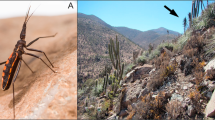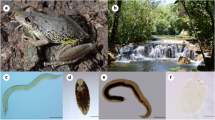Summary
On many small Caribbean islands, two species of Anolis lizard coexist, but the two are typically very different in body size. The two Anolis of St. Maarten, however, are exceptional because they are similar in size and are known to be strongly competitive. One species, A. gingivinus, appears the stronger competitor and occurs throughout the island; the other, A. wattsi, is found only in the central hills. The malarial parasite Plasmodium azurophilum very rarely infects A. wattsi, but in some locations is very common in A. gingivinus. Wherever malaria infects A. gingivinus, A. wattsi is present, but wherever malaria is absent, only A. gingivinus occurs. This pattern of coincidence of malaria and coexistence of both Anolis is observed over distances of only a few hundred meters. The parasite infects both red and white blood cells of A. gingivinus and causes important pathology: immature erthrocytes increase in abundance, blood hemoglobin decreases, monocytes and neutrophils increase, and infected white cells are less likely to produce acid phosphatase. These results argue that malaria mediates competition between the two species and determines the present distribution of the lizards on St. Maarten. This kind of parasite-mediated competition could be common if susceptibility to parasitic infection varies among competitors. The distribution of malaria in the Anolis of Caribbean islands suggests this parasite can play an important role in Anolis community ecology.
Similar content being viewed by others
References
Ayling AM (1981) The role of biological disturbance in temperate subtidal encrusting communities. Ecology 62: 830–847
Barbehenn KR (1969) Host-parasite relationships and species diversity in mammals: an hypothesis. Biotropica 1: 9–35
Crosby AW (1986) Ecological Imperialism. Cambridge Univ Press, Cambridge, UK
Dogiel VA (1966) General Parasitology. Academic Press, NY
Feener DH Jr (1981) Competition between ant species: outcome controlled by parasitic flies. Science 214: 815–817
Freeland WJ (1983) Parasites and the coexistence of animal host species. Am Natur 121: 223–236
Goldberg AF, Barka T (1964) Acid phosphatase activity in human blood cells. Nature 189: 297
Haldane JBS (1949) Disease and evolution. Ric Sci Suppl 19: 68–76
Holt RD (1984) Spatial heterogeneity, indirect interactions, and the coexistence of prey species. Am Nat 124: 377–406
Holt RD, Pickering J (1985) Infectious disease and species coexistence: A model of Lotka-Volterra form. Am Nat 126: 196–211
Lazell JD (1972) The anoles (Sauria, Iguanidae) of the Lesser Antilles. Bull Mus Comp Zool Harvard 143: 1–115
Loye JE, Zuk M (1991) Bird-parasite Interactions. Oxford Univ Press. Oxfored, UK
Minchella DJ, Scott ME (1991) Parasitism: A cryptic determinant of animal community structure. Trends Ecol Evol 6: 250–254
Pacala SW, Roughgarden J (1985) Population experiments with the Anolis lizards of St. Maarten and St. Eustatius. Ecology 66: 129–141
Paine RT (1977) Controlled manipulations in the marine intertidal zone, and their contributions to ecological theory 1776–1976. p 245–270. In: Goulden CE (ed) The changing scenes in natural sciences. Acad Nat Sci Phil Spec Publ 12: 245–270
Park T (1948) Experimental studies of interspecific competition. I. Competition between populations of flour beetles Tribodium confusum Duval and T. castaneum Herbst. Ecol Monogr 18: 265–307
Pianka ER (1988) Evolutionary Ecology, Fourth Edition, Harper and Row, New York
Price PW (1980) Evolutionary Biology of Parasites. Princeton Univ. Press, Princeton, N.J
Price PW, Westoby M, Rice B, Atsatt PR, Fritz RS, Thompson JN, Mobley K (1986) Parasite mediation in ecological interactions. Ann Rev Ecol Syst 17: 487–505
Price PW, Westoby M, Rice B (1988) Parasite-mediated competition: some predictions and tests. Am Natur 131: 544–555
Ressel S, Schall JJ (1989) Parasites and showy males: malarial infection and color variation in fence lizards. Oecologia 78: 158–164
Roughgarden J, Heckel D, Fuentes ER (1983) Coevolutionary theory and the biogeography and community structure of Anolis. In: Huey RB, Pianka ER, Schoener TW (eds) Lizard Ecology, Studies of a Model Organism. Harvard Univ Press, Cambridge, MA pp 371–410
Roughgarden JD, Pacala SW, Rummel JD (1984) Strong present-day competition between the Anolis lizard populations of St. Maarten (Neth. Antilles). In: Shorrocks B (ed) Evolutionary Ecology, Blackwell, London, pp 203–220
Roughgarden JD, Pacala S (1989) Taxon cycle among Anolis lizard populations: Review of evidence. In: Otte D, Endler JA (eds) Speciation and its Consequences. Sinauer, Sunderland, MA, pp 403–432
Schall JJ (1983a) Lizard malaria: cost to vertebrate host's reproductive success. Parasitology 87: 1–6
Schall JJ (1983b) Lizard malaria: parasite-host ecology. In: Huey RB, Pianka ER, Shoener TW (eds) Lizard Ecology, Studies on a Model Organism. Harvard Univ Press, Cambridge, MA, pp 84–100
Schall JJ (1986) Prevalence and virulence of a haemogregarine parasite of the Aruban whiptail lizard, Cnemidophorus arubensis. J Herpetol 20: 318–324
Schall JJ (1990a) Virulence of lizard malaria: the evolutionary ecology of an ancient parasite-host association. In: Keymer AE, Reed AF (eds) The Evolutionary Biology of Parasitism. Cambridge Univ. Press, Cambridge, UK, pp 35–52
Schall JJ (1990b) The ecology of lizard malaria. Parasit Today 6: 264–269
Schall JJ, Dearing MD (1987) Malarial parasitism and male competition for mates in the western fence lizard, Sceloporus occidentalis. Oecologia 73: 389–392
Schall JJ, Houle PR (1992) Malarial parasitism and home range and social status of male western fence lizards, Sceloporus occidentalis. J Herpetol 26: 74–76
Schall JJ, Sarni GA (1987) Malarial parasitism and the behavior of the lizard, Sceloporus occidentalis. Copeia 1987: 84–93
Schoener TW (1968) The Anolis lizards of Bimini: Resource partitioning in a complex fauna. Ecology 49: 704–726
Schoener TW (1969) Size patterns in West Indian Anolis lizards: I. Size and species diversity. System Zool 18: 386–401
Schoener TW (1979) Inferring the properties of predation and other injury-producing agents from injury frequencies. Ecology 60: 1110–1115
Sypek J, Borysenko M (1988) Reptiles. In: Rowley AF, Ratcliffe NA (eds) Vertebrate Blood Cells. Cambridge Univ Press, Cambridge, UK, pp 211–256
Telford SR (1975) Saurian malaria in the Caribbean: Plasmodium azurophilum sp. nov., a malaria parasite with schizogony and gametogony in both red and white cells. Int J Parasitol 7: 299–314
Telford SR (1984) Haemoparasites of reptiles. In: Hoff GL, Frye FL, Jacobson ER (eds) Diseases of Amphhibians and Reptiles Plenum Publ Corp, New York, pp 385–517
van Riper C, van Riper SG, Goff ML, Laird M (1986) The epizootiology and ecological significance of malaria in Hawaiian land birds. Ecol Monog 56: 327–344
Wheatley BP (1980) Malaria as a possible selective factor in the speciation of macaques. J Mammal 61: 307–311
Williams EE (1983) Ecomorphs, faunas, island size, and diverse end points in island radiations of Anolis. In: Huey RB, Pianka ER, Schoener TW (eds) Lizard Ecology, Studies of a Model Organism. Harvard Univ Press, Cambridge, MA, pp 326–370




